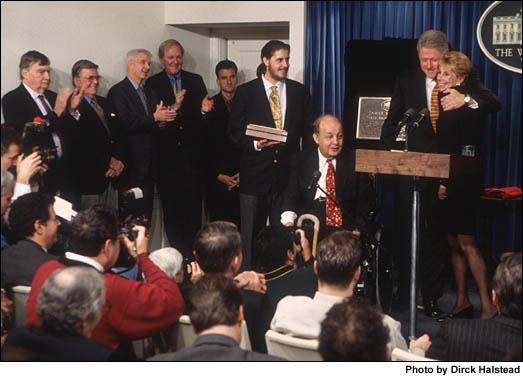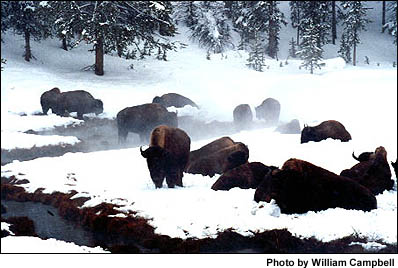 Washington, D.C., February 11, 2000 Former Presidential Press Secretaries gathered
in a rare meeting, to honor Reagan WH Press Secretary James Brady. The
White House press room was re-dedicated in his honor. Brady was paralyzed
by would-be assasin John Hinkley in an attempt on the life of President
Reagan in 1981. From left are Pierre Salinger (Kennedy), Larry Speakes
(Reagan), Jerry Ter Horst (Ford) and Mike McCury (Clinton), Brady's wife,
Sarah is given a hug by President Clinton. The Bradys have led a long fight
which has resulted in gun control legislation.
The contentious debate between Montana and the federal government over how to manage the last wild herd of buffalo was featured in a February 9th ABC Nightline report. “Buffalo Wars” was a collaboration between photojournalist William Campbell, reporter Maryanne Vollers, DigitalJournalist producer Rolf Behrens, and correspondent Chris Bury and producer Dan Green from ABC News Nightline. The majority of the project was shot by Campbell and Behrens on Sony DVCAM and edited by Behrens on Apple's Final Cut Pro. Campbell, a Time magazine contributing photographer, attended the first Platypus NPPA video workshop in 1999.
Radically faster film hailed as revolution in pictures. By Chris Tomlinson (The Independent - London) December 23, 1999 French scientists say they have found a way to produce photographic film that is 10 times more sensitive to light an advance that could make true-to-life pictures of candlelight dinners possible without a flash or muted colours. Agfa, the European film manufacturer that sponsored the photographic study and holds the patent, would not say when the film might become commercially available. Researchers also acknowledged that more work was needed to determine how well it could reproduce certain colours. But if the approach works, it could revolutionise photography, improving on the design that has been around since the 1840s. In the study published in Thursday's issue of the journal Nature, researchers at the University of Paris-Sud said they had captured all available light on film by adding a chemical. "A real breakthrough," said Richard Hailstone, a scientist at the Rochester Institute of Technology. The film uses two kinds of light-sensitive crystals halide and silver to produce an image. When light strikes one of the halide crystals it breaks an electron loose. Ideally, that electron combines with a nearby silver crystal. Later, when placed in a developer, the silver crystals darken and stick to the plastic. The result is a negative. The researchers added a chemical called formate to the crystals, which kept the loose electrons from recombining with the halide. It meant that every electron knocked loose was captured by a silver crystal. Jacqueline Belloni, the chief researcher,
said the technique could be used to make images with greater clarity or
to take pictures in very low light without a flash.
Philips CCD rivals 35-mm quality By Peter Clarke EE Times (12/09/99, 12:07 p.m. EDT) WASHINGTON - Digital still cameras could rival the image quality of 35-mm film photography within a couple of years due to a charge coupled device (CCD) image sensor with over six million pixels developed by Philips Semiconductors (Eindhoven, Netherlands). Herman Peek, a senior scientist at the company, presented a paper on the prototype device at this week's International Electron Devices Meeting. "This is the largest number of pixels and the smallest pixel size for a digital still camera ever published in the world," Peek said during the presentation of his paper. Although the prototype sensor is monochrome, and the use of red, green and blue filters would reduce resolution to 2 million tricolor pixels, Peek said the small size of individual light sensing elements, 3-micron x 3-micron, would allow such a sensor to rival small format film photography. "We are approaching the grain size of film, which is about 2 microns diameter, but image quality is also determined by the quality of the lens. The same thing effects CCD." Images produced using the sensor and displayed by Peek, albeit through an overhead projector system, were indistinguishable from images obtained from film. Individual hairs could been seen on the heads of head-and-shoulder portraits, which prompted congratulations from the audience. Peek said he expects to see a similar high-resolution CCD sensor in production within about two years, although it might include fewer pixels. "I don't think we will go to more pixels," he said. "We are already asking, 'Is six million too much and are we adding cost unnecessarily?' Perhaps five million or four million is the right amount." For a 2/3-inch format, Peck showed that the pixel size was on the limit of lens resolution, although the device could also be used for lens-less applications. The Philips CCD is built using a 0.5-micron CCD process operating at 14 volts and has an active area of 2,048 active lines and 3,072 active measuring 9.11 mm x 6.07 mm. The sensor has a dark current of 800 picoamperes/centimeter2 and a dynamic range of 63 dB. In his paper, Peek also discussed how novel techniques had been used to overcome problems with dark current suppression. The development of a high-resolution sensor using CCD technology represents a fight back by the technology against a challenge it faces from lower cost CMOS image sensors, which also allow the possibility of including signal processing and logic circuits on the same die. "CCD will always be expensive in comparison with CMOS image sensors," Peek said. "CCD can't compete with CMOS on price but it can on quality, and image quality is very important to consumers." |
 A
group of buffalo grazes and rests near a thermal fed creek in Yellowstone
National Park. If the buffalo cross the park border in search of
winter forage they will be captured and possibly sent to slaughter by the
Montana Department of Livestock. Nearly 1,300 Yellowstone buffalo have
been destroyed by Montana since 1996 in an attempt to protect cattle from
brucellosis.
A
group of buffalo grazes and rests near a thermal fed creek in Yellowstone
National Park. If the buffalo cross the park border in search of
winter forage they will be captured and possibly sent to slaughter by the
Montana Department of Livestock. Nearly 1,300 Yellowstone buffalo have
been destroyed by Montana since 1996 in an attempt to protect cattle from
brucellosis.